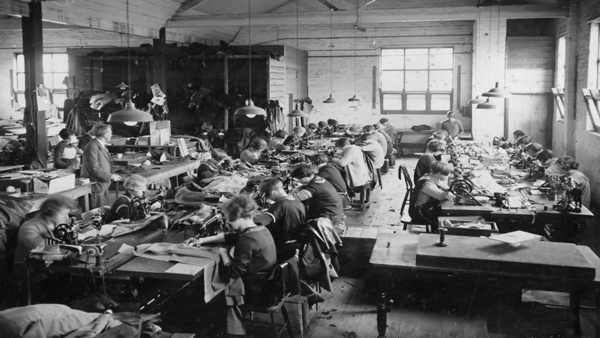In 1911, a bin of clippings caught on fire in a garment factory in Greenwich Village. The clippings—two months’ worth—were highly flammable, and the fire rapidly spread through the factory floor, blocking one of the staircases to the street. Workers rushed to flee the building, and some managed to escape to the roof before that exit was consumed by flames as well. The remaining workers might have escaped through another staircase—but it had been locked to prevent them from stealing anything, and the foreman who had the key had already fled to the roof. Firemen arrived straight away, but their ladders could not reach the eighth floor, and they could do nothing to stop the flames. Trapped inside, the workers—mostly young immigrant girls between the ages of 14 and 23—were forced to decide between the consuming flames and an impossible drop to the street below: 62 of them plummeted to their immediate deaths, and 142 died altogether.
The fire—known as the Triangle Shirtwaist Factory Fire—is a gruesome chapter in the history of American manufacturing. Yet it is simultaneously a symbol of the American labor movement: after the tragedy, New York state implemented a host of manufacturing regulations (e.g. mandatory fire escapes, on-site field inspections, limited work hours for women and children), labor unions grew more powerful, and the rest of the country soon followed suit in legislating working conditions. To this day, memorializations of the fire aim to reaffirm workers’ rights and fair labor practices.
While the fire calls to mind the progress America has made since 1911, it also reminds us of the continued legacy of labor abuses in American garment manufacturing. In more recent history, Thai workers were held captives as slaves in a garment factory in El Monte, California, in 1995. Today, garment workers in the United States are typically paid at piece-rate, or per item they sew, rather than at minimum wage. This means that garment workers end up making far less than minimum wage, often between $200 and $300 a week, for 60-70 hours. Adjusted for inflation, this is the same weekly average that the workers at the Triangle Shirtwaist Factory made. In recent years, the U.S. Department of Labor found this practice widespread among manufacturers of brands like Fashion Nova and Forever 21.
Once again, there is labor progress on the horizon for American garment manufacturing: last year, California passed a bill (SB.62) that outlawed piece-rate pay and holds both manufacturers and retailers legally responsible for garments made with illegal practices (at the federal level, only manufacturers and factories are held responsible, which disincentivizes retailers from ensuring their garments are made legally). And Kirsten Gillibrand is currently sponsoring a bill—the FABRIC Act—which would extend California’s regulations to the rest of the country.
The FABRIC Act also promises grants and tax incentives to manufacturers in order to reshore American garment jobs. If these jobs actually comply with new regulations, then reshoring stands to benefit American workers. However, what truly matters is that, wherever they are located, workers are sufficiently paid and provided healthy working conditions. We tend to assume that manufacturing jobs in America are de facto superior to manufacturing jobs in the developing world, with higher wages, better working conditions, and more oversight. But this assumption overlooks the history and reality of garment manufacturing in the United States, and it also ignores the progress many off-shore factories have made in workers’ welfare.
Bangladesh, for example, recently reaffirmed an accord to protect its garment workers, one which holds retailers legally responsible for labor practices in factories. Companies like New World Fashion Group in Vietnam and Busana Apparel Group in Indonesia strictly follow wage and overtime rules. These manufacturers also have loan programs that enable workers to buy motorbikes, they run health care education programs, and they offer household financial management courses. By collaborating with organizations such as Better Work, they remain compliant with national labor laws on compensation, contracts, occupational safety and health and working time.
To be clear, many factories abroad conduct inhumane and immoral labor practices—from child labor, to extortionate recruitment fees, to hazardous working conditions. But tags reading “Made in America” do not guarantee proper working conditions and fair wages, just as tags reading “Made in Vietnam” do not indicate improper working conditions and unfair wages. Only when tags tell us true wages, daily hours, and living conditions of workers will they be truly meaningful indicators of a garment’s ethical or unethical creation.
Labor Day calls us to celebrate workers. But celebration is useless without a clear-eyed picture of workers’ realities. On this Labor Day I suggest we contemplate whose labor we prioritize, whose labor we overlook, and what labor practices we ignore when we celebrate exclusively American labor. Instead, I suggest that we recognize and support best labor practices wherever they are practiced, with an eye towards spreading those practices to all workers around the world.

 By Oliver Niedermaier
By Oliver Niedermaier